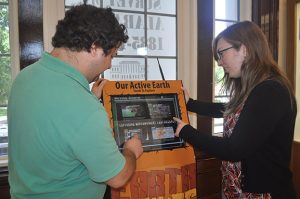Geological Sciences Partners with Museum of Natural History on Earth Science Display

From the June 2013 Desktop News | Students and visitors to UA’s Museum of Natural History will now have vast earth science and geology information at their fingertips in a new permanent display, thanks to a joint effort between the Department of Geological Sciences and the museum. The customizable, computer-based earth science display allows patrons to explore earth geology, geologic settings, historical earthquake accounts and recent research about seismic activity.
Known as an Active Earth Monitor Kiosk, the display was acquired on loan from the Incorporated Research Institutions for Seismology by Dr. Samantha Hansen, assistant professor of geological sciences. Hansen, who studies seismology, is one of two UA faculty members who are affiliated with the IRIS. After the loan term the museum and the department combined resources to purchase it.
“This technology puts geological research in the hands of the public and has the ability to convey more information than traditional exhibits,” Hansen said.
The kiosk uses touch-screen technology, and visitors can view maps of real-time earthquake data and actual earthquake activity that has happened in recent months. This particular machine was programed to display information about the New Madrid Seismic Zone, that stretches from Missouri all the way to nearby Mississippi and Tennessee. Hansen said this area was chosen because of its regional proximity to Alabama, which may be of interest to people.
Visitors can also read eye witness accounts of earthquakes that occurred more than a century ago, peruse pages of recent research with maps of national seismic hazards and information on newly discovered faults, and learn about the varied challenges of forecasting future earthquakes in this region.
“Kids, students and adults are captivated by the digital technology and are intrigued by the information they can find,” said Randy Mecredy, director of UA’s Museum of Natural History. “We often see them checking back to see if any new seismic activity occurred since their last visit.”
The display, which is located in the Rocks and Minerals exhibit in the museum’s Grand Gallery, is open to the public during the museum’s hours of 10 a.m. to 4:30 p.m. Monday through Saturday. Admission is $2 per person. The museum is located in Smith Hall at the corner of Sixth Avenue and Capstone Drive on the UA campus.